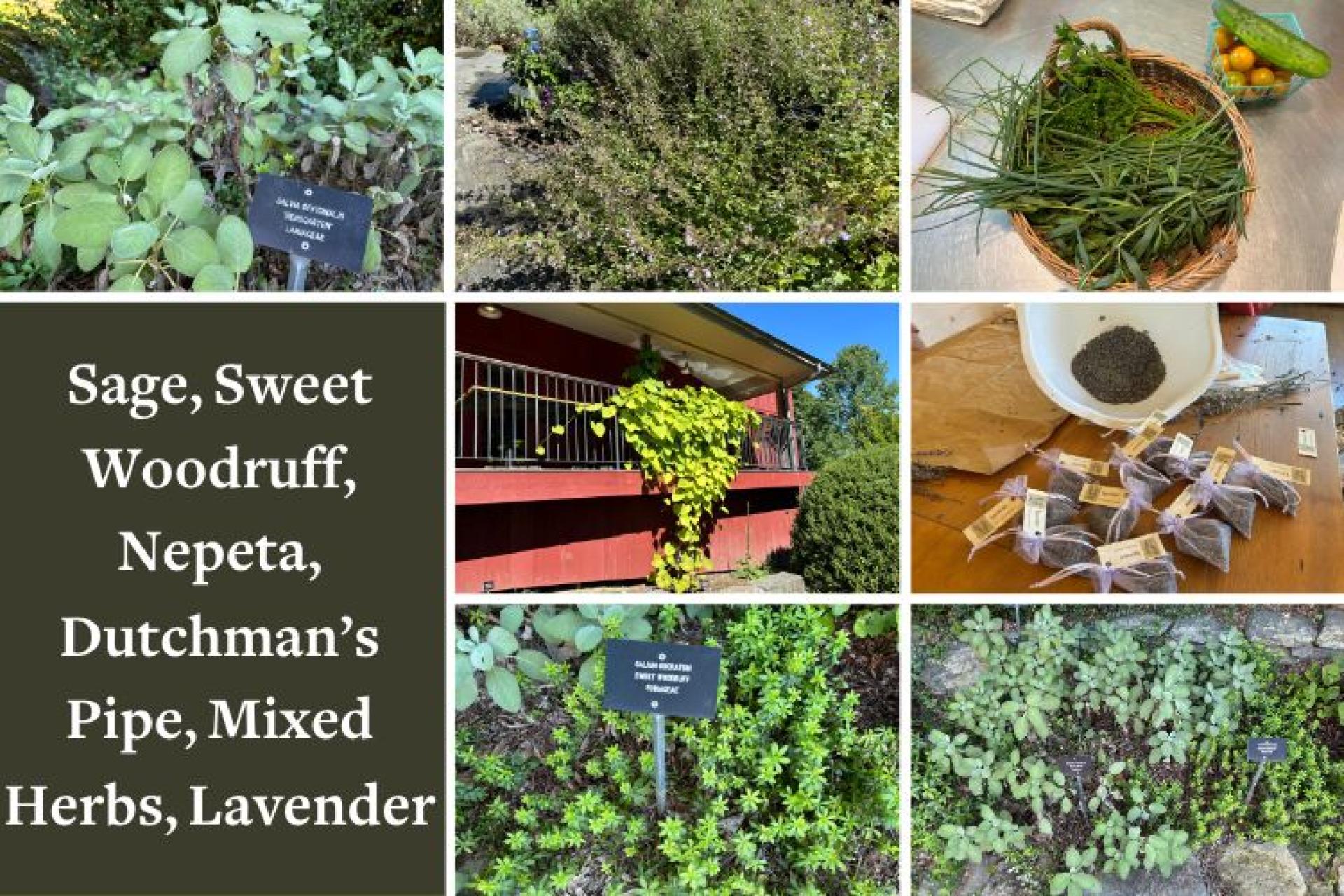You are here
What Is Happening in the BBG Herb Gardens and Kitchen This Week (Aug. 13)?
What Is Happening in the BBG Herb Gardens and Kitchen This Week (Aug. 13)?
By Barbara F. Smith
Let's talk texture!
When we gardeners are figuring out the “right plant for the right place,” we consider such factors as light, soil type, watering needs, and blooming time, to name a few. In a herb garden, we may group plants with similar purposes — e.g., culinary, fragrance, or dying fibers. Whether you maintain a strictly-herb garden or sprinkle your herbs in and among your flower or vegetable beds, many herbs can provide the added bonus of interesting foliage. This attribute is particularly appreciated at a time in mid-late summer when parts of the blooming garden appear to taking a rest.
Three herbs with good-looking foliage in the mid-August BBG Herb Display Gardens are sweet woodruff (Galium odoratum) paired with garden sage (Salvia officinalis “Berggarten”), and lesser catmint or Calamint (Calamintha nepeta).
Sweet woodruff is a slight (8 inches) plant which thrives in partial shade and friable, moist soil. It has whorls of pointed leaves surrounding its stem, and small, star-shaped white flowers that bloom in May. It is an indispensable ingredient for the traditional May wine or Mai Bowle, prepared by the Herb Associates at the start of the garden season. Sweet woodruff has also been used as a strewing herb, insect repellent and potpourri ingredient, as well as in sachets for linen or bedding drawers.
Sweet woodruff stands next to the Garden Sage, whose “officinalis” designation in its Latin name refers to the medicinal value of the sage, with a nod to its antimicrobial, antioxidant and antifungal properties. Garden sage is used widely for culinary purposes and in liqueurs and bitters. It has few cultivars, selected mainly for the color of its foliage or flowers. The variety “Berggarten,” as photographed, shows broad, silvery leaves. It is described as the “best agronomic plant of the available cultivars” (The Encyclopedia of Herbs by AO Tucker and T Debaggio). The pairing of the silvery sage with its elongated oval leaves next to the sweet woodruff’s dark green, fine leaves is particularly satisfying.
Lesser catmint, which appears in a sunnier bed in the Display Garden, is a herbaceous perennial growing to about 32 inches tall. It has a beautiful, blowsy structure with mint-scented foliage and small, late summer flowers. Their spreading habit requires space and sun to thrive, and their look may be more at home in a cottage or wild garden than in a tightly controlled border. These tough plants are resistant to heat, excess moisture and drought (sounds like our conditions!) and cold.
Finally, rounding out our discussion of textures in plants, I’ll give a nod to the Large Leaf Dutchman’s Pipe (Isotrema macrophyllum), which grows at the top of the herb garden, up to the balcony of the Center House. This fast-growing woody-stemmed vine, with its heart-shaped leaves that can grow to be a foot long, is ideal for creating privacy on your porch or patio. It grows 4-6 feet per year, ultimately reaching a height of 15-40 feet! Given the appropriate trellis, arbor or other support, it can cover the structure in one season. This plant prefers part shade and rich, moist soil, although they can adapt to average conditions. It is the main food source for the caterpillars of the blue pipe vine swallowtail butterfly.
Turning to the Kitchen Crew, this was a week of abundance of tarragon, which lead to the production of “J. Wilson’s Tarragon French Dressing,” “Sweet and Sour Herb Dressing,” and “Oil-Free Tarragon Vinegar.” A new batch of “Basil Simple Syrup” and “Shiso Simple Syrup” were prepared, which sound intriguing – a combination of savory and sweet flavors. Much of the earlier harvest of lavender blossoms have dried, and four Herb Associates were busy stripping the flowers from the stems, to be placed in organza sachets — a fragrant addition to your dresser drawers or under your bed pillows. As ever, work continued in bottling and labeling all the herb products which can be found at the Visitor Center’s Gift Shop.
Thank you for your ongoing interest in all things herbal at the Berkshire Botanical Garden!
The Berkshire Botanical Garden’s Herb Associates began in 1957 and have been making and selling products for the benefit of BBG ever since. At BBG, the Herb Associates oversee a display garden and production garden, both located near the Center House. Members/volunteers meet every Tuesday morning during the late spring through mid-autumn each year, coinciding when the gardens themselves are open to the public. Members plant, weed and tend the gardens, as well as harvest and process the variety of herbs.
Help Our Garden Grow!
Your donation helps us to educate and inspire visitors of all ages on the art and science of gardening and the preservation of our environment.
All Donations are 100 percent tax deductible.


